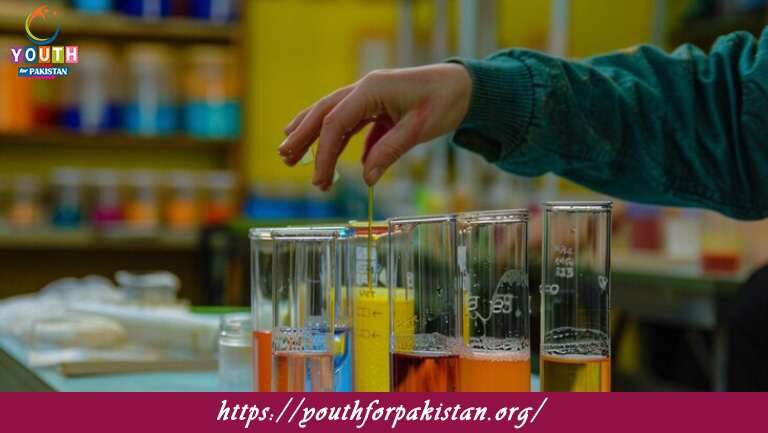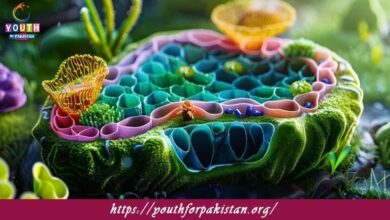11th Class Chemistry Chapter 9 MCQs with Answers

Dive into Solutions MCQs focusing on solubility, colligative properties, and concentration units. These Chapter 9 quizzes simplify the study of solutions for 11th Class Chemistry students preparing for exams.
What is the definition of a solution?
a) A homogeneous mixture of two or more substances
b) A heterogeneous mixture of two or more substances
c) A pure substance made up of only one type of atom
d) A pure substance made up of only one type of molecule
Which of the following is an example of a solid-solid solution?
a) Sugar dissolved in water
b) Salt dissolved in water
c) Alloys like brass and bronze
d) Carbon dioxide dissolved in water
What is the solvent in an aqueous solution of salt (NaCl) dissolved in water?
a) Water
b) Salt (NaCl)
c) Hydrogen
d) Oxygen
The component present in a smaller amount in a solution is called the:
a) Solvent
b) Solute
c) Solution
d) Solubility
Which of the following is an example of a gas-gas solution?
a) Oxygen gas dissolved in water
b) Carbon dioxide gas dissolved in water
c) Air (oxygen and nitrogen) in the atmosphere
d) Sugar dissolved in water
The process of dissolving a solid, liquid, or gas in a liquid solvent to form a homogeneous mixture is called:
a) Precipitation
b) Filtration
c) Solution
d) Solubility
Which of the following factors does not affect the solubility of a solute in a solvent?
a) Temperature
b) Pressure
c) Particle size of the solute
d) Polarity of the solute
The maximum amount of solute that can be dissolved in a given amount of solvent at a specific temperature is called:
a) Solute
b) Solvent
c) Solubility
d) Solution
The solubility of most solid solutes in water generally with an increase in temperature.
a) Increases
b) Decreases
c) Remains constant
d) Varies randomly
The solubility of most gases in water generally with an increase in temperature.
a) Increases
b) Decreases
c) Remains constant
d) Varies randomly
What does it mean if a solute is said to be “insoluble” in a solvent?
a) The solute cannot be dissolved in the solvent
b) The solute can be partially dissolved in the solvent
c) The solute can be completely dissolved in the solvent
d) The solute can only be dissolved in hot solvents
Which of the following is an example of a solid-liquid solution?
a) Oxygen gas dissolved in water
b) Carbon dioxide gas dissolved in water
c) Salt dissolved in water
d) Sugar dissolved in water
Which of the following is an example of a liquid-liquid solution?
a) Sugar dissolved in water
b) Salt dissolved in water
c) Ethanol dissolved in water
d) Oxygen gas dissolved in water
The concentration of a solution is defined as the:
a) Amount of solvent in the solution
b) Amount of solute in the solution
c) Ratio of solute to solvent in the solution
d) Amount of solution in the solvent
Which of the following statements is true about concentrated solutions?
a) They contain a large amount of solvent and a small amount of solute
b) They contain a small amount of solvent and a large amount of solute
c) They contain an equal amount of solvent and solute
d) They are always in a gaseous state
Which of the following is an example of a dilute solution?
a) A cup of strong coffee with little sugar
b) A cup of weak coffee with lots of sugar
c) A cup of pure water
d) A cup of black coffee with no sugar
The molarity (M) of a solution is defined as the number of moles of solute:
a) Dissolved in 1 liter of solvent
b) Dissolved in 1 liter of solution
c) Dissolved in 1 kilogram of solvent
d) Dissolved in 1 kilogram of solution
junkie-toggle title=”Answer” state=”closed”] b) Dissolved in 1 liter of solution [/junkie-toggle]
The symbol “mol/L” is used to represent the unit of:
a) Molarity
b) Molality
c) Mass percent
d) Mole fraction
Which of the following is the correct formula for calculating molarity (M) of a solution?
a) M = moles of solute / liters of solution
b) M = liters of solution / moles of solute
c) M = moles of solute * liters of solution
d) M = liters of solution * moles of solute
Which of the following is the correct formula for calculating molality (m) of a solution?
a) m = moles of solute / liters of solvent
b) m = moles of solute * kilograms of solvent
c) m = moles of solute / kilograms of solvent
d) m = moles of solute * liters of solvent
Which of the following statements is true about molality (m) of a solution?
a) It depends on temperature
b) It depends on pressure
c) It is independent of temperature
d) It is independent of pressure
The colligative properties of a solution depend on the:
a) Nature of the solute particles
b) Nature of the solvent particles
c) Number of solute particles
d) Volume of the solvent
Which of the following is a colligative property of a solution?
a) Boiling point elevation
b) Density of the solvent
c) Refractive index of the solvent
d) Melting point of the solute
The process of adding a solute to a solvent in order to lower the freezing point of the solvent is called:
a) Freezing point elevation
b) Boiling point elevation
c) Freezing point depression
d) Boiling point depression
Which of the following is not a colligative property of a solution?
a) Boiling point elevation
b) Vapor pressure lowering
c) Osmotic pressure
d) Density of the solution
What happens to the boiling point of a solution when a non-volatile solute is added to a solvent?
a) It increases
b) It decreases
c) It remains unchanged
d) It depends on the nature of the solvent
The presence of solute particles in a solution the vapor pressure of the solvent.
a) Increases
b) Decreases
c) Does not affect
d) Depends on the nature of the solute
Which of the following is a colligative property that is responsible for the process of osmosis?
a) Boiling point elevation
b) Freezing point depression
c) Vapor pressure lowering
d) Osmotic pressure
Osmosis is the movement of solvent molecules from an area of ____ solute concentration to an area of____solute concentration through a semipermeable membrane.
a) Lower; higher
b) Higher; lower
c) Higher; higher
d) Lower; lower
Which of the following is a characteristic of a semipermeable membrane?
a) It allows only solute particles to pass through
b) It allows only solvent particles to pass through
c) It allows both solute and solvent particles to pass through
d) It does not allow any particles to pass through
What is the effect of increasing the concentration of solute particles on the rate of osmosis?
a) It increases the rate of osmosis
b) It decreases the rate of osmosis
c) It does not affect the rate of osmosis
d) It stops osmosis
The process of osmosis is responsible for the movement of water in:
a) Plant roots
b) Plant leaves
c) Animal cells
d) All of the above
The osmotic pressure of a solution depends on the:
a) Nature of the solute particles
b) Nature of the solvent particles
c) Number of solute particles
d) Number of solvent particles
Which of the following statements is true about a hypertonic solution?
a) It has a lower concentration of solute particles than the cell
b) It has a higher concentration of solute particles than the cell
c) It has the same concentration of solute particles as the cell
d) It is an isotonic solution
Which of the following statements is true about a hypotonic solution?
a) It has a lower concentration of solute particles than the cell
b) It has a higher concentration of solute particles than the cell
c) It has the same concentration of solute particles as the cell
d) It is an isotonic solution
Which of the following statements is true about an isotonic solution?
a) It has a lower concentration of solute particles than the cell
b) It has a higher concentration of solute particles than the cell
c) It has the same concentration of solute particles as the cell
d) It is a hypotonic solution
What is the condition called when the osmotic pressure outside a cell is higher than the osmotic pressure inside the cell, causing the cell to shrink?
a) Crenation
b) Hemolysis
c) Plasmolysis
d) Turgor pressure
Which of the following is a common example of crenation?
a) A red blood cell in a hypotonic solution
b) A plant cell in a hypertonic solution
c) A plant cell in a hypotonic solution
d) A red blood cell in a hypertonic solution
Which of the following is a common example of plasmolysis?
a) A red blood cell in a hypertonic solution
b) A plant cell in a hypertonic solution
c) A red blood cell in a hypotonic solution
d) A plant cell in a hypotonic solution
Which of the following is a common example of hemolysis?
a) A red blood cell in a hypertonic solution
b) A plant cell in a hypertonic solution
c) A red blood cell in a hypotonic solution
d) A plant cell in a hypotonic solution
The process of separating the components of a solution based on their boiling points is called:
a) Filtration
b) Distillation
c) Crystallization
d) Chromatography
Which of the following is a common application of distillation?
a) Purification of drinking water
b) Separation of salt and sugar in a solution
c) Separation of different gases in air
d) Filtration of solid particles from a liquid solution
The process of separating a solute from a solution by cooling the solution and forming crystals is called:
a) Filtration
b) Distillation
c) Crystallization
d) Chromatography
Which of the following is a common application of crystallization?
a) Purification of drinking water
b) Separation of salt and sugar in a solution
c) Separation of different gases in air
d) Filtration of solid particles from a liquid solution
The process of separating the components of a solution based on their ability to move through a medium is called:
a) Filtration
b) Distillation
c) Crystallization
d) Chromatography
Which of the following is a common application of chromatography?
a) Purification of drinking water
b) Separation of salt and sugar in a solution
c) Separation of different gases in air
d) Analysis of plant pigments in biology
What is the role of the mobile phase in chromatography?
a) It is the medium through which the sample moves
b) It is the medium that absorbs the sample
c) It is the medium that separates the components of the sample
d) It is the medium that forms crystals from the sample
What is the role of the stationary phase in chromatography?
a) It is the medium through which the sample moves
b) It is the medium that absorbs the sample
c) It is the medium that separates the components of the sample
d) It is the medium that forms crystals from the sample
Which of the following is a common example of paper chromatography?
a) Separating the components of ink
b) Separating the components of air
c) Separating the components of saltwater
d) Separating the components of gasoline
Which of the following is a common example of gas chromatography?
a) Separating the components of ink
b) Separating the components of air
c) Separating the components of saltwater
d) Separating the components of gasoline
Which of the following is a common example of liquid chromatography?
a) Separating the components of ink
b) Separating the components of air
c) Separating the components of saltwater
d) Separating the components of gasoline
The separation technique used to separate the colors in a mixture based on their solubility is called:
a) Filtration
b) Distillation
c) Crystallization
d) Chromatography
Which of the following statements is true about solubility?
a) It is the ability of a solute to dissolve in a solvent
b) It is the ability of a solvent to dissolve in a solute
c) It is the ability of a solute to crystallize from a solution
d) It is the ability of a solvent to evaporate from a solution
The process of adding more solute to a saturated solution at a given temperature is called:
a) Precipitation
b) Filtration
c) Crystallization
d) Supersaturation
Which of the following statements is true about supersaturated solutions?
a) They contain less solute than a saturated solution at the same temperature
b) They contain more solute than a saturated solution at the same temperature
c) They contain the same amount of solute as a saturated solution at the same temperature
d) They are always unstable and form precipitates immediately
The process of forming solid crystals from a supersaturated solution is called:
a) Precipitation
b) Filtration
c) Crystallization
d) Supersaturation
Which of the following statements is true about precipitates?
a) They are formed in unsaturated solutions
b) They are formed in saturated solutions
c) They are formed in supersaturated solutions
d) They are formed in concentrated solutions
The process of removing solid particles from a liquid by passing the liquid through a filter is called:
a) Precipitation
b) Filtration
c) Crystallization
d) Supersaturation
Which of the following statements is true about filtration?
a) It is a method used to separate components of a solution based on their boiling points
b) It is a method used to separate components of a solution based on their solubility
c) It is a method used to remove solid particles from a liquid solution
d) It is a method used to remove gas particles from a liquid solution
The process of separating a mixture into its individual components by passing it through a column containing an adsorbent material is called:
a) Precipitation
b) Filtration
c) Crystallization
d) Chromatography
If you are interested to enhance your knowledge regarding Physics, Chemistry, Biology, and Computer please click on the link of each category, you will be redirected to dedicated website for each category.





